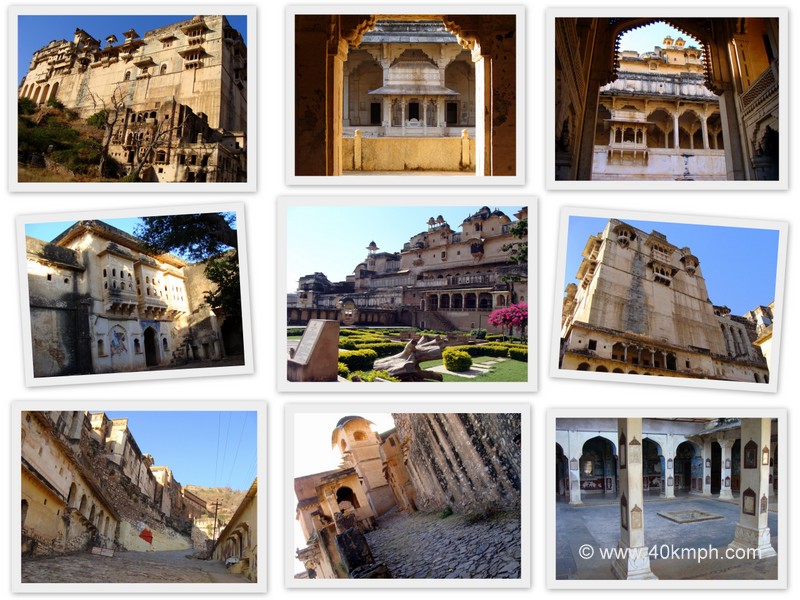Entry inside The Bundi Palace and Chitrashala is by tickets only.
Summer days timings are from 8 am – 7 pm and Winter 8 am – 5 pm.
After purchasing tickets for myself and Ashok Ji, I decided to hire guide services to learn more about the history. Keshav Bhati – Tour Escort / Guide ( mobile: 0 – 9414394241 ) Taragarh Fort was present. Tour Guide service charges Rs. 200.
Below is the summary of what I know about the historical palace and fort as narrated by Keshav Bhati and then during the Chitrasala visit N. K. Verma smarak parichar (monument attendant) enhanced further knowledge about paintings. Thanks to both of them.
- The Foundation of Bundi is from 1241. Before 1241, 300 tribal people were living here. The Chief of the tribal name was Bunda so the town was named after him as Bundi.
- The founder of Bundi was Rao Deva of the Chauhan family was from Ajmer and Delhi governed this region named as Hadoti after defeating Bunda. As Bundi was protected by three sides by Aravalli Hills, he decided to settle his capital at Bundi.
- Bundi was the capital governing Kota, Hadoti, Jhalawar, Sawai Madhopur, Tonk, etc.
- Ranjeet Singh was the last King of Bundi, who died on 8th January 2009.
- Bundi was never conquered by any other Kings or rulers.
- The Entrance Gate of the Palace is known as Hazari Darwaza because in earlier days 1000 soldiers always guarded the entrance.
- Till 1971, near the entrance at Naubat Khana music was played to welcome guests.
- 4 am wake-up call, 9 am start of the day, 12 noon the break, and 4 evening hours Nagara, Shehnai was played for various activities.
- The Palace was the location for the King and relatives to stay. Fort was to mount cannons, but sometimes for a change, it was visited by King.
- The fifth ruler of Bundi Rao Var Singh (1336-1393) built the Taragarh fort.
- Most parts of The Palace were closed to visitors and only opened for the last 8 years. Currently, Bhanwar Jitendra Singh (MP) of Alwar takes care of The Palace as well as the Fort.
- Not only at Hazari Darwaza – entrance gate, musicians were present, but at the Elephant Gate there is also a balcony for musicians and from the side, the structure rose water and flowers were showered as a gesture of welcome.
- The construction of Elephant Gate is 1620. Earlier Elephant Gate was known as Nauthano Ka Darwaja.
- In front of the Elephant gate is a stable for the horse and elephant and above is Deewan-e-Aam. King used to address the public at Deewan-e-Aam. Diwan-e-Aam (public audience) was built by Raja Ratan Doulat in the year 1607. Diwan-e-Aam other names are Darbar and Dari Khana.
- In earlier days there was a clock installed inside a pan that used to fill with water every one hour and the moment it is filled, the clock stuck and a sound is generated. Elephant Gate was also known as Ghadi (clock) ka Darwaza (gate). The clock is currently in the museum for display.
- Bundi population is approx. 95,000 mostly depend on agriculture such as basmati rice, oilseeds, soya, mustard, groundnut, sugarcane, lentils, and wheat.
- Diwan-e-Khaas – private audience such as family, relatives, King used to address during special occasions.
- At Banaras (Uttar Pradesh) there are ghats built by Bundi Kings.
- Chatramahal – palace area with lots of Chatris decorated with mosaic and doors decorated with ivory work.
- 1773-1821 paintings can be seen at Chitrasala – Shree Krishna Ras Leela, Govardhan Dharan, Cheerharan, Darbar, Seven head Airavata Hathi, Lady playing Yoyo. Mostly green and blue mineral colors are used in the paintings. Paintings by Sato Sar – The painter.
- Chitrasala also known as Umed Mahal.
- Maharaja Umed Singh at the age of 42 become a saint. One can see his sleepers at Chitrasala.
- Dhaka Malmal, Handmade paper part of Chitrasala.
